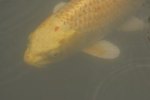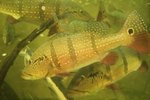
Attractive and easy to care for, goldfish tolerate a range of tank conditions, making them popular pet fish. Available in colors including silver, gold, red, orange and black, goldfish sometimes change color naturally, but black patches, especially on fin tips, can be a sign a fish has suffered chemical burns. Excess waste in goldfish tanks breaks down to form ammonia, an alkaline chemical that's harmful in high concentrations.
Ammonia
Goldfish with brown or black patches, or smudges, may have suffered ammonia burn but are healing. Fish waste, plant debris and uneaten food breaks down and produces ammonia, which raises the pH level of the water, causing it to burn goldfish's skin. When ammonia levels fall, fish begin to recover and heal -- the discolored patches are signs of healing skin. In tanks with constantly high ammonia levels, though, the patches may never appear. A fish whose skin never has an opportunity to heal won't develop brown or black patches.
Ammonia Poisoning
Excess levels of ammonia cause other symptoms in fish as well as turning their skins black. Fish suffering ammonia poisoning often behave strangely, floating on their sides, sitting at the bottom of the tank and gasping for oxygen at the surface. Hemorrhaging causes them to to develop pink or red gills and red streaks on their fins. Goldfish might also lose their appetites and look as though they're struggling to swim. Take swift action if you suspect your goldfish are suffering ammonia poisoning. Ammonia is colorless, so water clarity isn't a guide to ammonia levels.
Reducing Ammonia
Reducing high ammonia levels involves identifying and dealing with the causes. Goldfish eat and excrete more food than they need, so it's easy to overfeed them. They need as much food as the size of one of their eyes -- or as much as they can eat in two minutes -- two or three times a day. Install a tank filter or ensure yours is working properly, as it helps process fish waste. Regular water changes are also necessary. Every three or four weeks, replace 20 to 30 percent of the water with water that's been allowed to stand for three or four days.
Other Causes
Parasites are another cause of black patches on goldfish. They are the hosts for one stage of the parasite's life cycle after it leaves water snails. It burrows into fish skin and forms dark cysts that look like small dark spots. Infection is rare in indoor aquariums; when it does occur, fish develop large black patches. They usually show some signs of irritation such as flicking their bodies. Mature fish are unlikely to be seriously harmed. Removing snails from the tank is an effective cure.
References
Resources
Photo Credits
-
Jupiterimages/Photos.com/Getty Images
Writer Bio
A graduate of Leeds University, Jenny Green completed Master of Arts in English literature in 1998 and has been writing about travel, gardening, science and pets since 2007. Green's work appears in Diva, Whole Life Times, Listverse, Earthtimes, Lamplight, Stupefying Stories and other websites and magazines.




